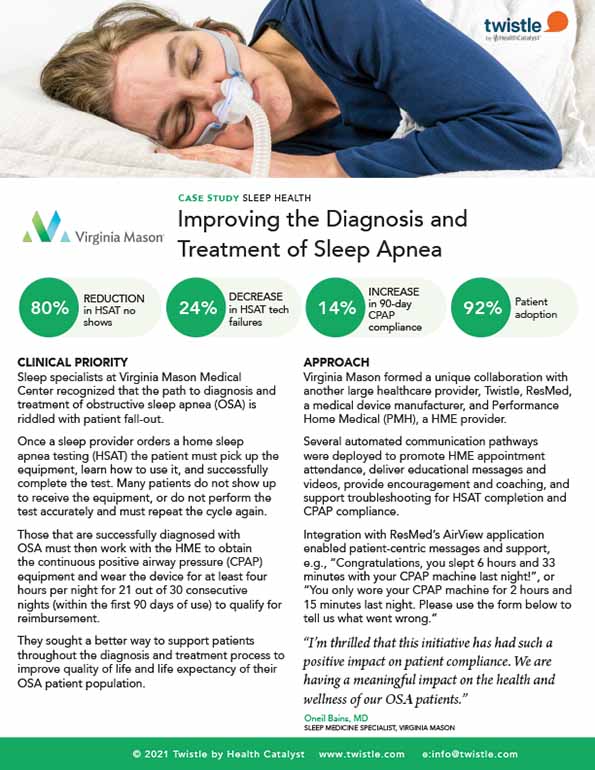Virginia Mason Medical Center collaborated with Twistle by Health Catalyst, another large healthcare provider, a medical device manufacturer, and an HME provider to deploy automated communication pathways. The pathways promote HME appointment attendance, deliver educational messages and videos, provide encouragement and coaching, and support troubleshooting for HSAT completion and CPAP compliance.
Sleep specialists at Virginia Mason Medical Center recognized that the path to diagnosis and treatment of obstructive sleep apnea (OSA) is riddled with patient fall-out.
Once a sleep provider orders a home sleep apnea testing (HSAT) the patient must pick up the equipment, learn how to use it, and successfully complete the test. Many patients do not show up to receive the equipment, or do not perform the test accurately and must repeat the cycle again.
Those that are successfully diagnosed with OSA must then work with the HME to obtain the continuous positive airway pressure (CPAP) equipment and wear the device for at least four hours per night for 21 out of 30 consecutive nights (within the first 90 days of use) to qualify for reimbursement.
They sought a better way to support patients throughout the diagnosis and treatment process to improve quality of life and life expectancy of their OSA patient population.
Virginia Mason formed a unique collaboration with another large healthcare provider, Twistle by Health Catalyst, ResMed, a medical device manufacturer, and Performance Home Medical (PMH), an HME provider.
Several automated communication pathways were deployed to promote HME appointment attendance, deliver educational messages and videos, provide encouragement and coaching, and support troubleshooting for HSAT completion and CPAP compliance.
Integration with ResMed’s AirView application enabled patient-centric messages and support, e.g., “Congratulations, you slept 6 hours and 33 minutes with your CPAP machine last night!”, or “You only wore your CPAP machine for 2 hours and 15 minutes last night. Please use the form below to tell us what went wrong.”
“I’m thrilled that this initiative has had such a positive impact on patient compliance. We are having a meaningful impact on the health and wellness of our OSA patients.”
Oneil Bains, MD
SLEEP MEDICINE SPECIALIST, VIRGINIA MASON
A six-month pilot using Twistle’s secure communication pathways took place between May and September of 2018. Performance data was compared to a control group of patients treated from May to September of 2017.
"We invest a lot in the HSAT - a technician has to set up the test, a courier has to deliver it, and the patient has to complete the test accurately. We consistently see reduced no shows and same day cancelations and fewer technical failures with patients enrolled in Twistle and that translates to significant savings for us."
Douglas Schmidt, PhD, DABSM
DIRECTOR, SLEEP DISORDER CENTER, VIRGINIA MASON
Simplification of the referral process from the sleep provider to the dispensing HME resulted in an 80 percent reduction in HSAT no-shows and a 4 percent increase in completed CPAP HME appointments.
This pilot demonstrated improved experience and quality of HSAT, improved delivery of CPAP to OSA patients and a successful integration of ResMed’s AirView database into Twistle workflows, all resulting in more patients with OSA being diagnosed and treated effectively. In addition, the ROI for both the diagnostic sleep centers and the HMEs was improved through reduced appointment no shows, improved technician productivity, increased patient adherence, and better CPAP reimbursement.


